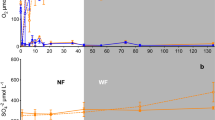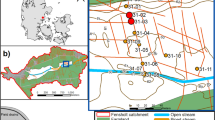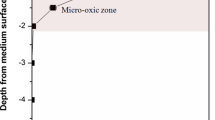Abstract
Background and aims
Although the role of microbial iron respiration in tidal marshes has been recognized for decades, the effect of rhizosphere processes on dissimilatory ferric iron reduction (FeR) is poorly known. Herein, we examined the FeR surrounding the root zone of three tidal marsh plants.
Methods
Using in situ rhizoboxes, we accurately separated rhizobox soil as one rhizosphere zone, and three bulk soil zones. Dissimilatory and sulfidic-mediated FeR were quantified by accumulation of non-sulfidic Fe(II) and Fe sulfides over time, respectively.
Results
The rates of dissimilatory FeR attained 42.5 μmol Fe g−1 d−1 in the rhizosphere, and logarithmically declined by up to 19.1 μmol Fe g−1 d−1 in the outer bulk soil. The rates of sulfidic-mediated FeR were less than 2 μmol Fe g−1 d−1 among all zones. Poorly crystalline Fe(III), DOC and DON, porewater Fe2+, and SO42− were all enriched in the rhizosphere, whereas non-sulfidic Fe(II) and Fe sulfides gradually accumulated away from the roots. Iron reducers (Geobacter, Bacillus, Shewanella, and Clostridium) had higher populations in the rhizosphere than in the bulk soil. Higher rates of dissimilatory FeR were observed in the Phragmites australis and Spartina alterniflora rhizoboxes than in the Cyperus malaccensis rhizoboxes.
Conclusions
The radial change pattern of dissimilatory FeR rates were determined by allocation of poorly crystalline Fe(III) and dissolved organic carbon. The interspecies difference of rhizosphere dissimilatory FeR was associated with the root porosity and aerenchyma of the tidal marsh plants.








Similar content being viewed by others
Abbreviations
- FeR:
-
Ferric iron reduction
- SR:
-
Sulfate reduction
- POR:
-
Percentage of root porosity
References
APHA (2005) American public health association. In: Eaton AD, Franson MAH (eds) Standard methods for the examination of water and wastewater, 21st edn. American Public Health Association, Washington, pp 3576–3578
Armstrong W, Justin SHFW, Beckett PM, Lythe S (1991) Root adaptation to soil waterlogging. Aquat Bot 39:57–73
Armstrong W, Cousins D, Armstrong J, Turner D, Beckett P (2000) Oxygen distribution in wetland plant roots and permeability barriers to gas-exchange with the rhizosphere: a microelectrode and modelling study with Phragmites australis. Ann Bot 86:687–703
Beck M, Dellwig O, Holstein JM, Grunwald M, Liebezeit G, Schnetger B, Brumsack H-J (2008) Sulphate, dissolved organic carbon, nutrients and terminal metabolic products in deep pore waters of an intertidal flat. Biogeochemistry 89:221–238
Bell C, Carrillo Y, Boot CM, Rocca JD, Pendall E, Wallenstein MD (2014) Rhizosphere stoichiometry: are C:N:P ratios of plants, soils, and enzymes conserved at the plant species-level? New Phytol 201:505–517
Bradford MA, Strickland MS, DeVore JL, Maerz JC (2012) Root carbon flow from an invasive plant to belowground foodwebs. Plant Soil 359:233–244
Burton ED, Sullivan LA, Bush RT, Johnston SG, Keene AF (2008) A simple and inexpensive chromium-reducible sulfur method for acid-sulfate soils. Appl Geochem 23:2759–2766
Cline JD (1969) Spectrophotometric determination of hydrogen sulfide in natural waters. Limnol Oceanogr 14:454–458
Colmer TD, Pedersen O (2008) Oxygen dynamics in submerged rice (Oryza sativa). New Phytol 178:326–334
Colombo C, Palumbo G, He J-Z, Pinton R, Cesco S (2014) Review on iron availability in soil: interaction of Fe minerals, plants, and microbes. J Soils Sediments 14:538–548
Cornell RM, Schwertmann U (2003) The iron oxides: structure, properties, reactions, occurrence and uses. Wiley-VCH Press. Weinheim, Germany, pp 2–3
Crowder AA, Macfie SM (1986) Seasonal deposition of ferric hydroxide plaque on roots of wetland plants. Can J Bot 64:2120–2124
el Zahar Haichar F, Santaella C, Heulin T, Achouak W (2014) Root exudates mediated interactions belowground. Soil Biol Biochem 77:69–80
Emerson D, Fleming EJ, Mcbeth JM (2010) Iron-oxidizing bacteria: an environmental and genomic perspective. Annu Rev Microbiol 64:561–583
Ferreira T, Otero X, Vidal-Torrado P, Macías F (2007) Effects of bioturbation by root and crab activity on iron and sulfur biogeochemistry in mangrove substrate. Geoderma 142:36–46
Finzi AC, Abramoff RZ, Spiller KS, Brzostek ER, Darby BA, Kramer MA, Phillips RP (2015) Rhizosphere processes are quantitatively important components of terrestrial carbon and nutrient cycles. Glob Chang Biol 21:2082–2094
Gribsholt B, Kristensen E (2002) Effects of bioturbation and plant roots on salt marsh biogeochemistry: a mesocosm study. Mar Ecol-prog Ser 241:71–87
Hafner S, Wiesenberg GL, Stolnikova E, Merz K, Kuzyakov Y (2014) Spatial distribution and turnover of root-derived carbon in alfalfa rhizosphere depending on top-and subsoil properties and mycorrhization. Plant Soil 380:101–115
Hartmann A, Schmid M, Tuinen DV, Berg G (2009) Plant-driven selection of microbes. Plant Soil 321:235–257
Hines ME, Knollmeyer SL, Tugel JB (1989) Sulfate reduction and other sedimentary biogeochemistry in a northern New England salt marsh. Limnol Oceanogr 34:578–590
Hinsinger P, Bengough AG, Vetterlein D, Young IM (2009) Rhizosphere: biophysics, biogeochemistry and ecological relevance. Plant Soil 321:117–152
Holmes DE, Finneran KT, O'Neil RA, Lovley DR (2002) Enrichment of members of the family Geobacteraceae associated with stimulation of dissimilatory metal reduction in uranium-contaminated aquifer sediments. Appl Environ Microbiol 68:2300–2306
Howarth R (1993) Microbial processes in salt-marsh sediments. Aquat Microbiol:239–260
Howarth RW, Jørgensen BB (1984) Formation of 35S-labelled elemental sulfur and pyrite in coastal marine sediments (Limfjorden and Kysing Fjord, Denmark) during short-term 35SO4 2− reduction measurements. Geochim Cosmochim Ac 48:1807–1818
Hung CH, Cheng CH, Cheng LH, Liang CM, Lin CY (2008) Application of Clostridium-specific PCR primers on the analysis of dark fermentation hydrogen-producing bacterial community. Int J Hydrogen Energ 33:1586–1592
Hyacinthe C, Bonneville S, Van Cappellen P (2006) Reactive iron(III) in sediments: chemical versus microbial extractions. Geochim Cosmochim Ac 70: 4166–4180
Hyun J-H, Smith AC, Kostka JE (2007) Relative contributions of sulfate-and iron(III) reduction to organic matter mineralization and process controls in contrasting habitats of the Georgia saltmarsh. Appl Geochem 22:2637–2651
Hyun J-H, Mok J-S, Cho H-Y, Kim S-H, Lee KS, Kostka JE (2009) Rapid organic matter mineralization coupled to iron cycling in intertidal mud flats of the Han River estuary, Yellow Sea. Biogeochemistry 92:231–245
Jia R, Li L-N, Qu D (2015) pH shift-mediated dehydrogenation and hydrogen production are responsible for microbial iron (III) reduction in submerged paddy soils. J Soils Sediments 15:1178–1190
Jia R, Li L, Qu D, Mi N (2018) Enhanced iron (III) reduction following amendment of paddy soils with biochar and glucose modified biochar. Environ Sci Pollut R 25:91–103
Johnston SG, Keene AF, Bush RT, Burton ED, Sullivan LA, Isaacson L, McElnea AE, Ahern CR, Smith CD, Powell B (2011) Iron geochemical zonation in a tidally inundated acid sulfate soil wetland. Chem Geol 280:257–270
Jones ME, Beckler JS, Taillefert M (2011) The flux of soluble organic-iron(III) complexes from sediments represents a source of stable iron(III) to estuarine waters and to the continental shelf. Limnol Oceanogr 56:1811–1823
Karanfil T, Erdogan I, Schlautman MA (2003) Selecting filter membranes for measuring DOC and UV254. J Am Water Works Assoc 95:86–100
Khan N, Seshadri B, Bolan N, Saint CP, Kirkham MB, Chowdhury S, Yamaguchi N, Lee DY, Li G, Kunhikrishnan A (2016) Root iron plaque on wetland plants as a dynamic pool of nutrients and contaminants. Adv Agron 138:1–96
King G, Garey MA (1999) Ferric iron reduction by bacteria associated with the roots of freshwater and marine macrophytes. Appl Environ Microbiol 65:4393–4398
Kirwan ML, Mudd SM (2012) Response of salt-marsh carbon accumulation to climate change. Nature 489:550–553
Kludze HK, DeLaune RD, Patrick WH (1993) Aerenchyma formation and methane and oxygen exchange in rice. Soil Sci Soc Am J 57:386–391
Koop-Jakobsen K, Wenzhöfer F (2015) The dynamics of plant-mediated sediment oxygenation in Spartina anglica rhizospheres-a planar optode study. Estuar Coasts 38:951–963
Koop-Jakobsen K, Fischer J, Wenzhöfer F (2017) Survey of sediment oxygenation in rhizospheres of the saltmarsh grass-Spartina anglica. Sci Total Environ 589:191–199
Kostka JE, Luther GW III (1994) Partitioning and speciation of solid phase iron in saltmarsh sediments. Geochim Cosmochim Ac 58:1701–1710
Kostka JE, Roychoudhury A, Van Cappellen P (2002) Rates and controls of anaerobic microbial respiration across spatial and temporal gradients in saltmarsh sediments. Biogeochemistry 60: 49–76
Kristensen E, Mangion P, Tang M, Flindt MR, Holmer M, Ulomi S (2011) Microbial carbon oxidation rates and pathways in sediments of two Tanzanian mangrove forests. Biogeochemistry 103:143–158
Laanbroek H (1990) Bacterial cycling of minerals that affect plant growth in waterlogged soils: a review. Aquat Bot 38:109–125
Lambers H, Mougel C, Jaillard B, Hinsinger P (2009) Plant-microbe-soil interactions in the rhizosphere: an evolutionary perspective. Plant Soil 321:83–115
Lemanceau P, Bauer P, Kraemer S, Briat JF (2009) Iron dynamics in the rhizosphere as a case study for analyzing interactions between soils, plants and microbes. Plant Soil 321:513–535
Lentini CJ, Wankel SD, Hansel CM (2012) Enriched iron (III)-reducing bacterial communities are shaped by carbon substrate and iron oxide mineralogy. Front Microbiol 3:404
Li YL, Fan XR, Shen QR (2008) The relationship between rhizosphere nitrification and nitrogen-use efficiency in rice plants. Plant Cell Environ 31:73–85
Li H, Peng J, Weber KA, Zhu Y (2011) Phylogenetic diversity of Fe (III)-reducing microorganisms in rice paddy soil: enrichment cultures with different short-chain fatty acids as electron donors. J Soils Sediments 11:1234–1242
Li X, Liu T, Li F, Zhang W, Zhou S, Li Y (2012) Reduction of structural Fe(III) in oxyhydroxides by Shewanella decolorationis S12 and characterization of the surface properties of iron minerals. J Soils Sediments 12:217–227
Li H, Huang G, Meng Q, Ma L, Yuan L, Wang F, Zhang W, Cui Z, Shen J, Chen X (2013) Integrated soil and plant phosphorus management for crop and environment in China. A review Plant soil 349:157–167
Li X, Hou L, Liu M, Zheng Y, Yin G, Lin X, Cheng L, Li Y, Hu X (2015) Evidence of nitrogen loss from anaerobic ammonium oxidation coupled with ferric iron reduction in an intertidal wetland. Environ Sci Technol 49:11560–11568
Lin H, Shi J, Bei W, Yang J, Chen Y, Zhao Y, Hu T (2010) Speciation and biochemical transformations of sulfur and copper in rice rhizosphere and bulk soil-XANES evidence of sulfur and copper associations. J Soils Sediments 10:907–914
Liu W, Zhu Y, Hu Y, Williams P, Gault A, Meharg A, Charnock J, Smith F (2006) Arsenic sequestration in Iron plaque, its accumulation and speciation in mature Rice plants (Oryza Sativa L.). Environ Sci Technol 40:5730–5736
Longstreth DJ, Borkhsenious ON (2000) Root cell ultrastructure in developing aerenchyma tissue of three wetland species. Ann Bot 86:641–646
Lovley DR, Phillips EJ (1986) Organic matter mineralization with reduction of ferric iron in anaerobic sediments. Appl Environ Microbiol 51:683–689
Luo M, Zeng C-S, Tong C, Huang J-F, Yu Q, Guo Y-B, Wang S-H (2014) Abundance and speciation of iron across a subtropical tidal marsh of the Min River estuary in the East China Sea. Appl Geochem 45:1–13
Luo M, Huang J, Tong C, Liu Y, Duan X, Hu Y (2017) Iron dynamics in a subtropical estuarine tidal marsh: the roles of seasonality and plants. Mar Ecol-prog Ser 577:1–15
Ma X-M, Zarebanadkouki M, Kuzyakov Y, Blagodatskaya E, Pausch J, Razavi BS (2018) Spatial patterns of enzyme activities in the rhizosphere: effects of root hairs and root radius. Soil Biol Biochem 118:69–78
Mitsch WJ, Gosselink JG (2015) Tidal marshes. In wetlands, 5th edn. John Wiley & Sons, Inc, Hoboken, pp 259–310
Moeslundi L, Thamdrup B, Jørgensen BB (1994) Sulfur and iron cycling in a coastal sediment: radiotracer studies and seasonal dynamics. Biogeochemistry 27:129–152
Muyzer G, Teske A, Wirsen CO, Jannasch HW (1995) Phylogenetic relationships of Thiomicrospira species and their identification in deep-sea hydrothermal vent samples by denaturing gradient gel electrophoresis of 16S rDNA fragments. Arch Microbiol 164:165–172
Neubauer SC, Givler K, Valentine SK, Megonigal JP (2005) Seasonal patterns and plant-mediated controls of subsurface wetland biogeochemistry. Ecology 86:3334–3344
Neubauer SC, Toledo-Durán GE, Emerson D, Megonigal JP (2007) Returning to their roots: Iron-oxidizing Bacteria enhance short-term plaque formation in the wetland-plant rhizosphere. Geomicrobiol J 24:65–73
Neubauer S, Emerson D, Megonigal J (2008) Microbial oxidation and reduction of iron in the root zone and influences on metal mobility. John Wiley and Sons, Hoboken, NJ, pp 339–371
Otero X, Ferreira T, Vidal-Torrado P, Macías F (2006) Spatial variation in pore water geochemistry in a mangrove system (Pai Matos island, Cananeia-Brazil). Appl Geochem 21:2171–2186
Peng Q-A, Shaaban M, Wu Y, Hu R, Wang B, Wang J (2016) The diversity of iron reducing bacteria communities in subtropical paddy soils of China. Appl Soil Ecol 101:20–27
Poulton SW, Canfield DE (2005) Development of a sequential extraction procedure for iron: implications for iron partitioning in continentally derived particulates. Chem Geol 214:209–221
Roden EE, Wetzel RG (2002) Kinetics of microbial Fe(III) oxide reduction in freshwater wetland sediments. Limnol Oceanogr 47:198–211
Schulze D (1981) Identification of soil iron oxide minerals by differential X-ray diffraction. Soil Sci Soc Am J 45:437–440
Seeberg-Elverfeldt J, Schlüter M, Feseker T, Kölling M (2005) Rhizon sampling of pore waters near the sediment/water interface of aquatic systems. Limnol Oceanogr Methods 3:361–371
Seyfferth AL (2015) Abiotic effects of dissolved oxyanions on iron plaque quantity and mineral composition in a simulated rhizosphere. Plant Soil 397:43–61
Seyfferth AL, Webb SM, Andrews JC, Fendorf S (2011) Defining the distribution of arsenic species and plant nutrients in rice (Oryza sativa L.) from the root to the grain. Geochim Cosmochim Ac 75:6655–6671
Snoeyenbos-West OL, Nevin KP, Anderson RT, Lovley DR (2000) Enrichment of Geobacter species in response to stimulation of Fe(III) reduction in sandy aquifer sediments. Microb Ecol 39:153–167
St-Cyr L, Crowder AA (1989) Factors affecting iron plaque on the roots of Phragmites australis (Cav.) Trin. ex Steudel. Plant Soil 116:85–93
Sundby B, Vale C, Caetano M, Luther Iii GW (2003) Redox chemistry in the root zone of a salt marsh sediment in the Tagus estuary, Portugal. Aquat Geochem 9:257–271
Taggart MA, Mateo R, Charnock JM, Bahrami F, Green AJ, Meharg AA (2009) Arsenic rich iron plaque on macrophyte roots-an ecotoxicological risk? Environ Pollut 157:946–954
Tong C, Wang W-Q, Huang J-F, Gauci V, Zhang L-H, Zeng C-S (2012) Invasive alien plants increase CH4 emissions from a subtropical tidal estuarine wetland. Biogeochemistry 111:677–693
Wang J, Vollrath S, Behrends T, Bodelier PLE, Muyzer G, Meimafranke M, Oudsten FD, Cappellen PV, Laanbroek HJ (2011) Distribution and diversity of Gallionella-like neutrophilic iron oxidizers in a tidal freshwater marsh. Appl Environ Microbiol 77:2337–2344
Wang X, Chen R, Jing Z, Yao T, Feng Y, Lin X (2018) Root derived carbon transport extends the rhizosphere of rice compared to wheat. Soil Biol Biochem 122:211–219
Weber KA, Achenbach LA, Coates JD (2006) Microorganisms pumping iron: anaerobic microbial iron oxidation and reduction. Nat Rev Microbiol 4:752–764
Weiss JV, Emerson D, Backer SM, Megonigal JP (2003) Enumeration of Fe(II)-oxidizing and Fe(III)-reducing bacteria in the root zone of wetland plants: implications for a rhizosphere iron cycle. Biogeochemistry 64:77–96
Weiss JV, Emerson D, Megonigal JP (2004) Geochemical control of microbial Fe(III) reduction potential in wetlands: comparison of the rhizosphere to non-rhizosphere soil. FEMS Microbiol Ecol 48:89–100
Weiss JV, Emerson D, Megonigal JP (2005) Rhizosphere Iron(III) deposition and reduction in a L.-dominated wetland. Soil Sci Soc Am J 69:1861–1870
Weiss JV, Rentz JA, Plaia T, Neubauer SC, Merrill-Floyd M, Lilburn T, Bradburne C, Megonigal JP, Emerson D (2007) Characterization of neutrophilic Fe(II)-oxidizing Bacteria isolated from the rhizosphere of wetland plants and description of Ferritrophicum radicicola gen. nov. sp. nov., and Sideroxydans paludicola sp. nov. Geomicrobiol J 24:559–570
Weston NB, Dixon RE, Joye SB (2006) Ramifications of increased salinity in tidal freshwater sediments: geochemistry and microbial pathways of organic matter mineralization. J Geophys Res-Biogeo 111(2005–2012):1–14
Whitmire S, Hamilton S (2008) Rates of anaerobic microbial metabolism in wetlands of divergent hydrology on a glacial landscape. Wetlands 28:703–714
Wu Q, Sanford RA, Löffler FE (2006a) Uranium(VI) reduction by Anaeromyxobacter dehalogenans strain 2CP-C. Appl Environ Microbiol 72:3608–3614
Wu S, Zhong J, Huan L (2006b) Genetics of subpeptin JM4-a and subpeptin JM4-B production by Bacillus subtilis JM4. Biochem Bioph Res Co 344:1147–1154
Yang JX, Liu Y, Zhi-Hong YE (2012) Root-induced changes of pH, eh, Fe(II) and fractions of Pb and Zn in rhizosphere soils of four wetland plants with different radial oxygen losses. Pedosphere 22:518–527
Yang J, Tam NF-Y, Ye Z (2014) Root porosity, radial oxygen loss and iron plaque on roots of wetland plants in relation to zinc tolerance and accumulation. Plant Soil 374:815–828
Zhang P, Nie M, Li B, Wu J (2017) The transfer and allocation of newly fixed C by invasive Spartina alterniflora and native Phragmites australis to soil microbiota. Soil Biol Biochem 113:231–239
Zhuang L, Xu J, Tang J, Zhou S (2015) Effect of ferrihydrite biomineralization on methanogenesis in an anaerobic incubation from paddy soil. J Geophys Res-Biogeo 120:876–886
Acknowledgments
This work was financially supported by the National Science Foundation of China (Grant No. 41501252), the Science Foundation of Fujian Province (Grant No. 2016 J05097), Key Laboratory of wet Subtropical Ecology and geography process of Ministry of Education (Grant No. 2017KFJJ02), Key Laboratory of Coastal Environmental Processes and Ecological Remediation, YICCAS (Grant No. 2018KFJJ10), and the Open Test Fund for valuable instruments and equipment from Fuzhou University (2018 T013). We thank the Elsevier Web shop for its assistance with language editing during the preparation of this manuscript.
Author information
Authors and Affiliations
Corresponding author
Additional information
Responsible Editor: Gustavo Gabriel Striker.
Electronic supplementary material
ESM 1
(DOC 156 kb)
Rights and permissions
About this article
Cite this article
Luo, M., Liu, Y., Huang, J. et al. Rhizosphere processes induce changes in dissimilatory iron reduction in a tidal marsh soil: a rhizobox study. Plant Soil 433, 83–100 (2018). https://doi.org/10.1007/s11104-018-3827-y
Received:
Accepted:
Published:
Issue Date:
DOI: https://doi.org/10.1007/s11104-018-3827-y




